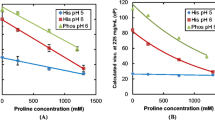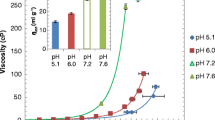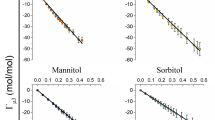Abstract
Purpose
Histidine is a commonly used buffer in formulation of monoclonal antibodies (mAb), often with excipients like sucrose. The objective of this study was to examine the effects of both histidine and sucrose on the biophysical characteristics of a mAb.
Methods
The hydrodynamic radius of the mAb was determined by dynamic light scattering and confirmed by size exclusion chromatography. Data were also obtained for the osmotic virial coefficients (from osmotic pressure measurements), the solution viscosity, and the mAb thermal stability (using differential scanning calorimetry) at selected conditions.
Results
There were no significant changes in mAb conformation / stability as determined by DSC. The hydrodynamic radius initially increased with increasing histidine concentration, going through a maximum at a histidine concentration of about 20 mM. The addition of sucrose increased the mAb hydrodynamic radius at all histidine concentrations by about 0.5 nm. The observed effects of histidine and sucrose on the hydrodynamic radius were also reflected in changes in the osmotic pressure and solution viscosity.
Conclusions
These results provide important insights into the effects of both histidine and sucrose on the behavior of concentrated mAb solutions, including the potential impact on ultrafiltration / diafiltration processes.









Similar content being viewed by others
Abbreviations
- ε:
-
Permittivity of medium (C2 s2 / kg / m3)
- ζ:
-
Surface potential (V)
- κ:
-
Inverse Debye length (m−1)
- η:
-
Viscosity of mAb solution (Pa s)
- μ:
-
Solvent viscosity (Pa s)
- ∆P:
-
Pressure difference (Pa)
- ΔΠ:
-
Osmotic pressure difference between the solutions (Pa)
- σo :
-
Osmotic reflection coefficient
- b:
-
Viscosity parameter (L/g)
- Bi :
-
Osmotic virial coefficients
- Cmax :
-
Maximum protein concentration in viscosity correlation (g/L)
- Cp :
-
mAb concentration
- DLS:
-
Dynamic light scattering
- DSC:
-
Differential scanning calorimetry
- Jv :
-
Filtrate flux (L/m2 h)
- L:
-
Capillary length (m)
- Lp :
-
Membrane Permeability (L/m2 h bar)
- mAb:
-
Monoclonal Antibody
- Mp :
-
Molecular weight of the mAb (Da)
- ms :
-
Molar salt concentration (mM)
- MW:
-
Dextran molecular weight (Da)
- Q:
-
Volumetric flow rate (m3)
- R:
-
Capillary radius (m)
- rs :
-
Hydrodynamic radius (nm)
- SEC:
-
Size exclusion chromatography
- T:
-
Absolute temperature (K)
- Tm :
-
Melting temperature in differential scanning calorimetry (K)
- UF:
-
Ultrafiltration
- Z:
-
Net protein charge
References
Wang W, Singh S, Zeng DL, King K, Nema S. Antibody structure, instability, and formulation. J Pharm Sci. 2007;96(1):1–26.
Rosenberg AS. Effects of protein aggregates: an immunologic perspective. AAPS J. 2006;8:E501–7.
Jiskoot W, Randolph TW, Volkin DB, Middaugh CR, Schöneich C, Winter G, et al. Protein instability and immunogenicity: roadblocks to clinical application of injectable protein delivery systems for sustained release. J Pharm Sci. 2012;101(3):946–54.
Salinas BA, Sathish HA, Bishop SM, Harn N, Carpenter JF, Randolph TW. Understanding and modulating opalescence and viscosity in a monoclonal antibody formulation. J Pharm Sci. 2010;99(1):82–93.
Binabaji E, Ma J, Zydney AL. Intermolecular interactions and the viscosity of highly concentrated monoclonal antibody solutions. Pharm Res. 2015;32(9):3102–9.
Chen B, Bautista R, Yu K, Zapata GA, Mulkerrin MG, Chamow SM. Influence of histidine on the stability and physical properties of a fully human antibody in aqueous and solid forms. Pharm Res. 2003;20(12):1952–60.
Al-Hussein A, Gieseler H. Investigation of histidine stabilizing effects on LDH during freeze-drying. J Pharm Sci. 2013;102(3):813–26.
Tian F, Middaugh CR, Offerdahl T, Munson E, Sane S, Rytting JH. Spectroscopic evaluation of the stabilization of humanized monoclonal antibodies in amino acid formulations. Int J Pharm. 2007;335(1):20–31.
Chavez BK, Agarabi CD, Read EK, Boyne Ii MT, Khan MA, Brorson KA. Improved stability of a model IgG3 by DoE-based evaluation of buffer formulations. Biomed Res Int. 2016;3:2074149.
Lam XM, Oeswein JQ, Ongpipattanakul B, Shahrokh Z, Wang SX, Weissburg RP, et al. Antibody formulation. U.S. Patent No. 6,171,586, 2001.
Wang W. Lyophilization and development of solid protein pharmaceuticals. Int J Pharm. 2000;203(1):1–60.
Kamerzell TJ, Esfandiary R, Joshi SB, Middaugh CR, Volkin DB. Protein-excipient interactions: mechanisms and biophysical characterization applied to protein formulation development. Adv Drug Deliv Rev. 2001;63(13):1118–59.
Arakawa T, Timasheff SN. Stabilization of protein structure by sugars. Biochemistry. 1982;21(25):6536–44.
Back JF, Oakenfull D, Smith MB. Increased thermal stability of proteins in the presence of sugars and polyols. Biochemistry. 1979;18(23):5191–6.
Abbas SA, Sharma VK, Patapoff TW, Kalonia DS. Characterization of antibody-polyol interactions by static light scattering: implications for physical stability of protein formulations. Int J Pharm. 2013;448(2):382–9.
Lim DG, Kim NA, Lim JY, Kim KH, Hada S, Jeong SH. Evaluation of etanercept stability as exposed to various sugars with biophysical assessment. Int J Pharm. 2014;476(1):50–9.
Lim JY, Kim NA, Lim DG, Eun CY, Choi D, Jeong SH. Biophysical stability of hyFc fusion protein with regards to buffers and various excipients. Int J Biol Macromol. 2016;86:622–9.
Oliver JD, Anderson S, Troy JL, Brenner BM, Deen WH. Determination of glomerular size-selectivity in the normal rat with Ficoll. J Am Soc Nephrol. 1992;3(2):214–28.
Perkins TW, Saksena S, van Reis R. A dynamic film model for ultrafiltration. J Membr Sci. 1999;158(1):243–56.
Wu J, Prausnitz JM. Osmotic pressures of aqueous bovine serum albumin solutions at high ionic strength. Fluid Phase Equilib. 1999;155(1):139–54.
Vilker VL, Colton CK, Smith KA. The osmotic pressure of concentrated protein solutions: effect of concentration and pH in saline solutions of bovine serum albumin. J Colloid Interface Sci. 1981;79(2):548–66.
Castellanos MM, Pathak JA, Colby RH. Both protein adsorption and aggregation contribute to shear yielding and viscosity increase in protein solutions. Soft Matter. 2014;10(1):122–31.
Mooney M. The viscosity of a concentrated suspension of spherical particles. J Colloid Sci. 1951;6(2):162–70.
Neergaard MS, Nielsen AD, Parshad H, Van De Weert M. Stability of monoclonal antibodies at high-concentration: head-to-head comparison of the IgG1 and IgG4 subclass. J Pharm Sci. 2014;103(1):115–27.
Annunziata O, Buzatu D, Albright JG. Protein diffusion coefficients determined by macroscopic-gradient rayleigh interferometry and dynamic light scattering. Langmuir. 2005;21(26):12085–9.
Schmitz KS. Introduction to dynamic light scattering by macromolecules. San Diego: Academic Press; 1990.
Ahrer K, Buchacher A, Iberer G, Josic D, Jungbauer A. Analysis of aggregates of human immunoglobulin G using size-exclusion chromatography, static and dynamic light scattering. J Chromatogr A. 2003;1009(1):89–96.
Lin AWSM, Castell DO. Evidence of the importance of pH and salt concentration on column chromatography with Sepharose gel filtration in separation of proteins. Anal Biochem. 1978;86(2):345–56.
Roberts CJ, Nesta DP, Kim N. Effects of temperature and osmolytes on competing degradation routes for an IgG1 antibody. J Pharm Sci. 2013;102(10):3556–66.
Binabaji E, Rao S, Zydney AL. The osmotic pressure of highly concentrated monoclonal antibody solutions: effect of solution conditions. Biotechnol Bioeng. 2014;111(3):529–36.
Quemada D. Energy of interaction in colloids and its implications in rheological modeling. Adv Colloid Interface Sci. 2002;98(1):51–85.
Saito S, Hasegawa J, Kobayashi N, Kishi N, Uchiyama S, Fukui K. Behavior of monoclonal antibodies: relation between the second virial coefficient (B2) at low concentrations and aggregation propensity and viscosity at high concentrations. Pharm Res. 2012;29(2):397–410.
Liao SM, Du QS, Meng JZ, Pang ZW, Huang RB. The multiple roles of histidine in protein interactions. Chem Cent J. 2013;7(1):44.
Heyda J, Mason PE, Jungwirth P. Attractive interactions between side chains of histidine-histidine and histidine-arginine-based cationic dipeptides in water. J Phys Chem B. 2010;114(26):8744–9.
ACKNOWLEDGMENTS AND DISCLOSURES
The authors would like to acknowledge Bristol-Myers Squibb for donation of the monoclonal antibody used in this work and for their financial support.
Author information
Authors and Affiliations
Corresponding author
Rights and permissions
About this article
Cite this article
Baek, Y., Singh, N., Arunkumar, A. et al. Effects of Histidine and Sucrose on the Biophysical Properties of a Monoclonal Antibody. Pharm Res 34, 629–639 (2017). https://doi.org/10.1007/s11095-016-2092-0
Received:
Accepted:
Published:
Issue Date:
DOI: https://doi.org/10.1007/s11095-016-2092-0




